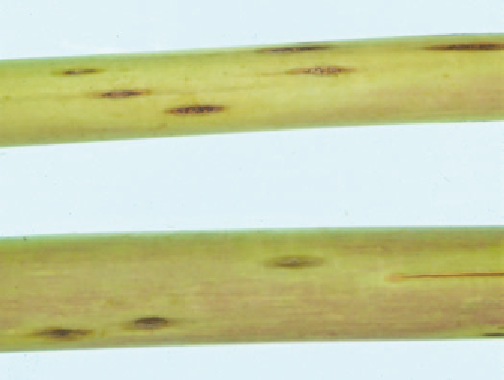Agriculture Reference
In-Depth Information
Fig 14.21 Brown spot symptoms on a papaya leaf stalk.
Management
•
Apply recommended fungicides, particularly when
conditions favour the disease.
PHOMOPSIS ROT (WET FRUIT ROT)
■
Cause
The fungus
Phomopsis caricae-papayae
.
Symptoms
Although commonly occurring at the stem end,
Phomopsis rot can develop anywhere on the surface of
fruit. Initial symptoms are soft, water-soaked lesions on
the surface of ripening fruit. The developing rot
penetrates deeply into the f lesh. Infected tissue is soft,
mushy and wet.
Fig 14.22 Phomopsis rot on ripe papaya fruit. Inset: an early lesion.
Management
•
Avoid very susceptible lines when selecting seed.
Apply the recommended fungicides to fruit in plantations.
•
In advanced stages of infection, white mycelial growth
dotted with numerous black fruiting bodies (pycnidia) may
appear on the surface of lesions.
Treat fruit with fungicides after harvest.
•
Remove and destroy dying leafstalks, taking care not
to damage fruit.
•
Source of infection and spread
Fungal spores develop on senescing leaf stalks and are
spread to fruit during wet weather. Latent infections may
be formed in the peel or stem end of green fruit before
harvest. Alternatively, spores present on the surface of fruit
at harvest may germinate and enter through the freshly cut
surface of the stem end. Lesions develop rapidly as the fruit
ripens. Spread of the disease after harvest from fruit to
fruit is not significant.
PHYTOPHTHORA FRUIT, ROOT
AND STEM ROTS
■
Cause
The oomycetes
Phytophthora palmivora
and
Phytophthora
nicotianae
.
Symptoms
Water-soaked spots develop on mature fruit and enlarge to
produce large lesions covered by a white fungal crust, often
Importance
Phomopsis rot can cause considerable losses of ripe fruit
before or after harvest.












